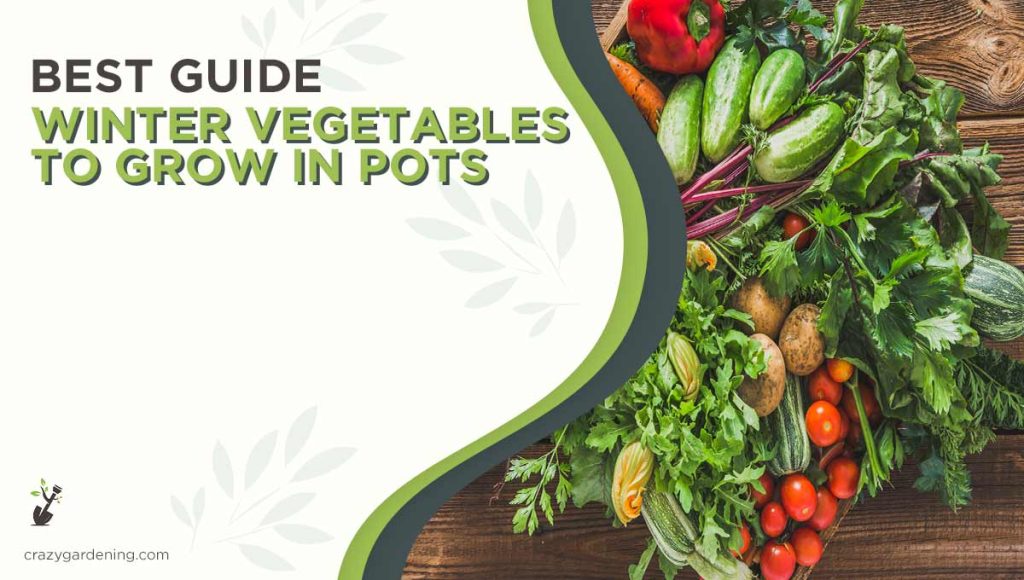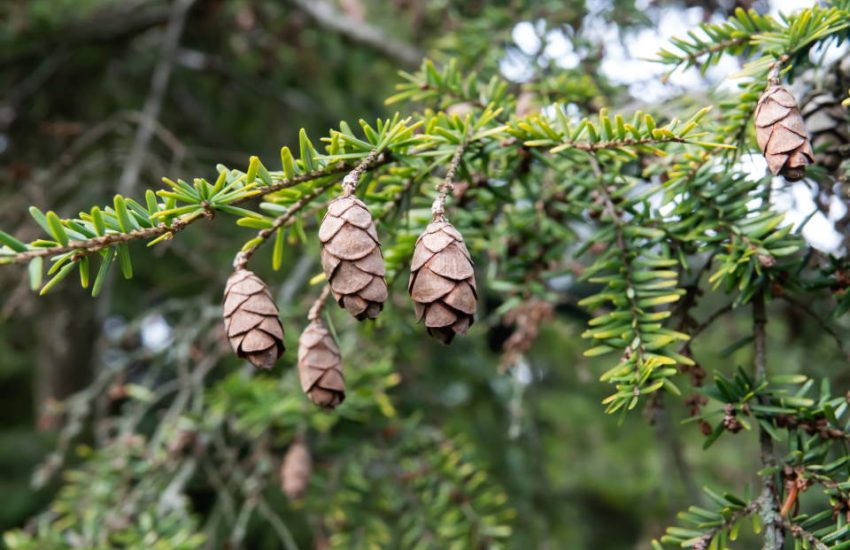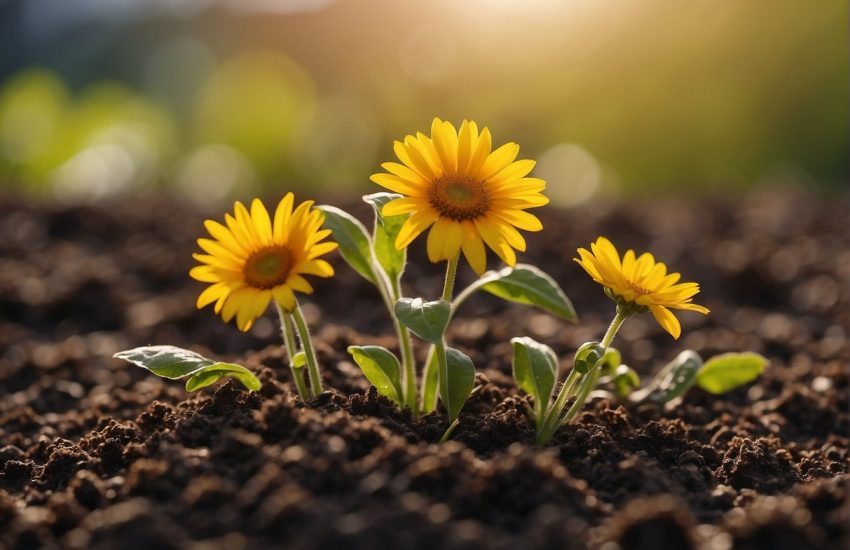7 Best Winter Vegetables to Grow in Pots – Frozen Harvest 2025
If you’re like most people, you probably spend the majority of your time during the winter huddled indoors, trying to stay warm.
But just because it’s cold outside doesn’t mean you can’t enjoy fresh, homegrown vegetables. There are plenty of winter vegetables that can be grown in pots.
With a little effort and by using spade, you can have a bounty of fresh produce right at your fingertips. After growing them you have to maintain your spade.
Best Winter Vegetables to Grow in Pots

Potatoes
Potatoes are one of the most versatile vegetables out there. They can be used in a variety of dishes, from soups and stews to roasted potatoes. And they’re one of the easiest vegetables to grow in container.
Procedure
All you need is a large pot or container, some potting soil, and a potato. You can either start with a seed potato or a regular potato from the grocery store.
Just make sure that the potato has at least two eyes or buds on it.
Cut the potato in half so that each half has at least one eye. Plant the potato halves about four inches deep in the potting soil. Water well and wait for the plants to sprout.
When they reach about six inches tall, you can hill them by adding more soil around the base of the plant. This will give the potatoes more room to grow.
Continue to water and fertilize as needed. When the plants begin to flower, it’s a sign that the potatoes are starting to form. Harvest them when the vines have died back halfway, about 17 weeks after planting. Gently pull or dig out tubers with a garden fork. It is very easy to damage the potatoes if not careful in the process.
Carrots
Growing carrots in the winter is a great and difficult thing in the south. Carrots are a root vegetable and can be difficult to grow in the winter because of the freezing temperatures.
The ground can freeze and make it hard for the carrots to get the nutrients they need.
Procedure
To grow carrots in pots, you will need to start with a soil mix that is high in organic matter. You can add compost or manure to the potting mix to achieve this.
Carrots require full sun and well-drained soil to grow properly. Sow the seeds about inch deep and 1 inch apart in the pot.
Water well and keep the soil moist until the seeds have germinated. Once the plants have reached about 3 inches tall, you can thin them out so that they are about 4 inches apart.
Carrots need to be watered regularly, especially during hot, dry periods. Apply a layer of mulch around the plants to help retain moisture. Fertilize every few weeks with a balanced fertilizer.
Harvest carrots when they are about to 1 inch in diameter. Larger carrots can be left in the ground to mature, but they may become woody and tough.
Cabbage
Cabbage is a cool weather crop that can be grown in container. It’s a great source of vitamins and minerals, and it can be used in a variety of dishes, from salads to slaw.
Procedure
To grow cabbage in a pot, you’ll need a large pot or container, some potting soil, and seedlings or seeds. If you’re starting with seedlings, plant them according to the instructions on the packaging.
If you’re starting with seeds, sow them about inch deep in the soil. Water well and wait for the plants to grow.
kale
Kale is a nutrient-rich leafy green that can be grown in pots. It’s a great source of vitamins A, C, and K, as well as calcium and iron.
Procedure
Put it 1/2 inch deep in the soil. Kale needs full sun to partial shade and well-drained soil. Water regularly and fertilize every few weeks with a balanced fertilizer.
Harvest kale when the leaves are about 6 inches long. You can cut the entire plant at once, or you can harvest individual leaves as needed. Kale will continue to produce new leaves even after it’s been harvested.
Beets
Beets are a root vegetable that is related to Swiss chard and spinach. They can be grown in pots, and they’re a great source of vitamins and minerals.
Procedure
To grow beets in a pot, you’ll need a large pot or container, some potting soil, and seedlings or seeds. If you’re starting with seedlings, plant them according to the instructions on the packaging.
If you’re starting with seeds, sow them about inch deep in the soil. Water well and wait for the plants to grow.
Beets need full sun and well-drained soil to grow properly. Apply a layer of mulch around the plants to help retain moisture. Fertilize every
Eight to nine weeks before the first fall frost, you can start planting beets and hardening them off. Beets can be sown in the spring or the late autumn.
It is advisable to use containers that are at least 24 inches across and 10 inches deep because certain beet kinds can grow quite huge. In a row, space the seeds 1 to 2 inches apart.
Watering beets should be done about every other day. Try to aim for wet soil rather than soaking it, as with the majority of the veggies on this list.
Beets can endure colder temperatures than their lush green cousins since they are also cold resilient.
Although they can survive a little frost, it may be advisable to bring them inside to wait it out if a heavy frost is a forecast.
Bell Pepper
Bell peppers come in a variety of colors, including red, yellow, and orange. They can be grown in container, and they’re a great source of vitamins and minerals.
Procedure
Bell Pepper needs to be an accurate amount of water for their growth. You can use a soaker hose to water them if you need to. The soil should be kept moist but not soggy.
Bell peppers need full sun to partial shade and well-drained soil. Fertilize every three weeks with a balanced fertilizer. Harvest bell peppers when they are fully grown and their color is bright.
Broccoli
Broccoli is a nutrient-rich vegetable that can be grown in pots. It’s a great source of vitamins and minerals, and it can be used in a variety of dishes, from salads to stir-fries.
Procedure
The ideal container for broccoli is five gallons, and its roots can extend 12 to 18 inches deep. While monitoring the soil’s level of dryness, water your plants by around 1.5 inches every week.
Consider double your watering frequency if the soil dries up rapidly and the broccoli leaves begin to wilt.
Why Grow Winter Vegetables in Container?
There are many benefits to growing winter vegetables in pots.
Healthy Vegetables
Pots can be placed in a sunny spot, even if there is snow on the ground. This means that you can still get fresh, healthy vegetables even in the middle of winter.
Pots are also portable, so you can move them around to make sure they get the right amount of sunlight.
Control Soil Quality
Another benefit of growing winter vegetables in pots is that you can control the soil quality and drainage. This is important because plants need well-drained soil to grow properly.
By growing your winter vegetables in pots, you can make sure that they get the best possible conditions for growth.
Save Money
Finally, growing winter vegetables in pots is a great way to save money.
You can reuse the same pot for multiple seasons, and you won’t have to buy as much produce from the store. Plus, you’ll know that your vegetables are fresh and free of pesticides.
After growing them you have to keep your area neat and clean. There are many ways to do it, but you can remove leaves geniously by using rake.
What are the Easiest Vegetables to Grow in Container?
Here are a few easy-to-grow vegetables that can be grown in pots:
Salad greens
Salad greens such as lettuce, arugula, and spinach are easy to grow in pots and can be grown indoors or outdoors. They prefer well-draining soil and partial sun, and they are relatively low maintenance.
Tomatoes
Tomatoes are a popular choice for growing in pots, and many varieties are well suited to container gardening. They prefer well-draining soil and full sun, and they need regular watering and fertilizing to thrive.
Peppers
Peppers are another vegetable that is well suited to container gardening. They prefer well-draining soil and full sun, and they need regular watering and fertilizing to thrive.
Radishes
Radishes are a quick-growing root vegetable that can be grown in pots. They prefer well-draining soil and full sun, and they are relatively low maintenance.
Carrots
Carrots can be grown in pots as long as the container is deep enough to accommodate their long roots. They prefer well-draining soil and full sun, and they are relatively low maintenance.
Conclusion
Growing winter vegetables in container is a great way to get fresh, healthy produce all winter long.
You can control the soil quality and drainage, and you can save money by reusing the same pot for multiple seasons.
You can grow vegetables like broccoli, beets, potatoes, carrots, and bell peppers in container. These plants can withstand a lot of cold weather.
Just make sure to keep them well-watered and protected from frost. For added warmth, you can place your container on a sunny windowsill or wrap them in blankets or towels at night.
FAQs
Question
What vegetables grow best in pots during winter?
Answer
The fastest growing winter vegetables include kale, spinach, lettuce, arugula, radishes, and turnips. These vegetables can be grown in cold temperatures and have a short maturity time.
Question
What are the fastest growing winter vegetables?
Answer
Root vegetables like carrots, parsnips, turnips, and sweet potatoes are great for winter as they are hearty, nutritious, and can be stored for long periods.
Question
What vegetable is best for winter?
Answer
Small, compact vegetables like cherry tomatoes, lettuce, spinach, radishes, and herbs like basil and parsley are great options for container gardening.
Question
What is the shortest vegetable growing season?
Answer
Microgreens have the shortest growing season, with some varieties taking as little as 7-14 days from planting to harvest, making them a great option for quick homegrown greens.
Question
What can I grow in pots in winter UK?
Answer
>- Here are a few vegetables that can be grown in pots in the winter in the UK: 1. Salad greens 2. Radishes 3. Carrots 4. Peas 5. Spinach
Question
What can I plant in pots all year round?
Answer
There are several vegetables that can be grown in pots all year round, including salad greens, radishes, carrots, peas, and spinach. Other options include herbs such as basil, chives, and parsley, as well as compact varieties of vegetables like tomatoes, peppers, and eggplants. It is important to choose a pot with adequate drainage and to ensure that the plants receive enough sunlight and water to thrive.


